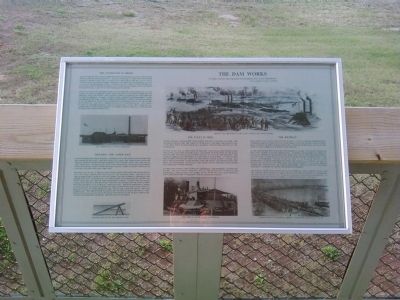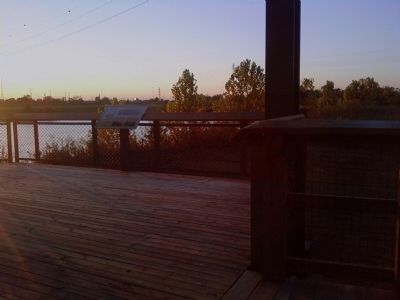Pineville in Rapides Parish, Louisiana — The American South (West South Central)
The Dam Works
The Lexington is freed
By May 8, the water level had risen five feet four inches, allowing the lighter draft gunboats, the Fort Hindman, Neosho, and Osage, to cross the upper rapids and wait behind the dams. Fearing that the structure would not hold, General Banks informed Admiral Porter to put his boats "in readiness to take advantage of the higher water." Porter paid little heed to the concerns of Banks and made no effort to reduce the weight of his vessels, many of which were reportedly laden with captured bales of cotton.
On May 9, at 5:30 a.m., General Banks' fears were realized when two of the barges in the dam broke loose, and water began to pour through the opening. Only one vessel, the 177-foot long gunboat Lexington was prepared to attempt a crossing. Without stopping, the Lexington steered directly for the break in the dam. As she entered the roaring torrent with a full head of steam, the boat "hung for a moment, with a harsh, grating sound, on the rocks below," and was carried safely into deeper water. The three gunboats anchored behind the dam soon followed. The other boats, unprepared to make the crossing, watched as the water fell and remained trapped behind the upper rapids.
Building the Upper Dam
Bailey immediately began building another dam at the upper rapids to free the remainder of the fleet. This dam, built just above the upper rapids (near the present Missouri Pacific Railroad Bridge), was constructed in the same way as the lower dam. Several small tree dams were built in the river extending from the Pineville side toward the main channel, while a larger crib dam was constructed from the Alexandria side.
Between May 10 and 12, the remaining boats struggled over the upper shoals into the pool behind the main dam at the lower rapids. the ironclad Chillicothe barely made it over the rapids, and the gunboats Carondelet and Mound City went aground and "lay side by side with their bellies across the reefs" blocking the path of the three remaining vessels. To free the two boats, Bailey, with the help of Lieutenant Colonel Uri Pearsall of the 99th Colored Infantry, devised a plan to build a "bracket dam." This dam, formed of a series of two-legged trestles anchored to the river bottom and connected by a diagonal wall of overlapping planks, would add a foot of water. The dam worked, but the added water was still not enough to float the boats. They were eventually hauled over the rocks with blocks and tackle, windlasses, and five-inch hawsers manned by 3,000 men pulling in unison.
The fleet is free
Having finally cleared the upper rapids, the fleet was not yet free. The remaining boats were the largest and heaviest, and they still had to pass over the lower rapids through a narrow 70-foot-wide opening in the lower dam.
On May 12, at 6 p.m., as thousands of military and civilian spectators lined the banks and bands marched back and forth on both sides of the river playing the "Star Spangled Banner" and the "Battle Cry for Freedom," the gunboat Mound City prepared to cross the lower rapids. As she entered the rushing water, the crew and the crowd ashore raised a cheer. Her hull struck bottom, water poured over the stern, and momentarily he boat lay motionless. Gradually the vessel moved forward and floated into the quiet waters beyond.
On the same evening, the gunboats, Carondelet, and Pittsburg crossed the rapids. The following morning, May 13, the remaining gunboats, the Louisville, Chillicothe, and Ozark, along with two tugs, successfully navigated the rapids to freedom. Bailey's dam had worked.
The Retreat
With the fleet safely below the rapids, General Banks ordered the combined forces to move out of Alexandria. It is not known exactly how fires started or who started them, but as Banks retreated, much of the town of Alexandria was burned to the ground.
As the expedition moved south, Confederate cavalry continued to harass the Union troops at every opportunity. Numerous skirmishes occurred in Avoyelles Parish as the troops made their way east to the Mississippi River. Taylor made a four-hour stand near Mansura before withdrawing. The final Confederate attack came on May 17, at Yellow Bayou near Simmesport, as Banks prepared to cross the Atchafalaya River. On May 18, Bailey was again called upon, this time to construct a floating bridge across the Atchafalaya. He used 25 transport vessels fastened together with heavy timbers to create the temporary bridge.
The forces under Banks moved on to Baton Rouge while Porter's fleet and the troops from Sherman's army steamed up the Mississippi to Vicksburg. The Red River Campaign was over, but Bailey's Dam remained behind, "an imperishable monument of American energy, ingenuity, and skill."
Topics. This historical marker is listed in this topic list: War, US Civil. A significant historical month for this entry is May 1775.
Location. 31° 19.265′ N, 92° 26.973′ W. Marker is in Pineville, Louisiana, in Rapides Parish. Marker is on Riverfront Street west of Main Street, on the left when traveling west. Marker pavilion is located at the Forts Randolph and Buhlow State Historic Site, on the left after you go through the entrance gates. Touch for map. Marker is at or near this postal address: 135 Riverfront Street, Pineville LA 71360, United States of America. Touch for directions.
Other nearby markers. At least 8 other markers are within walking distance of this marker. The Red River Campaign (here, next to this marker); Bailey's Dam (here, next to this marker); Who was Stationed at Fort Randolph (approx. 0.2 miles away); Why was Fort Randolph Built? (approx. ¼ mile away); How was Fort Randolph Built? (approx. ¼ mile away); Desertion and the end of the War (approx. 0.3 miles away); Deserting soldiers and the end of the war (approx. 0.4 miles away); Who was Fort Buhlow named after? (approx. 0.4 miles away). Touch for a list and map of all markers in Pineville.
Related markers. Click here for a list of markers that are related to this marker. To better understand the relationship, study each marker in the order shown.
Credits. This page was last revised on June 16, 2016. It was originally submitted on November 29, 2010, by Lee Hattabaugh of Capshaw, Alabama. This page has been viewed 868 times since then and 17 times this year. Photos: 1, 2. submitted on November 29, 2010, by Lee Hattabaugh of Capshaw, Alabama. • Craig Swain was the editor who published this page.
Editor’s want-list for this marker. A clear and readable close-up photo of the marker. • Can you help?

